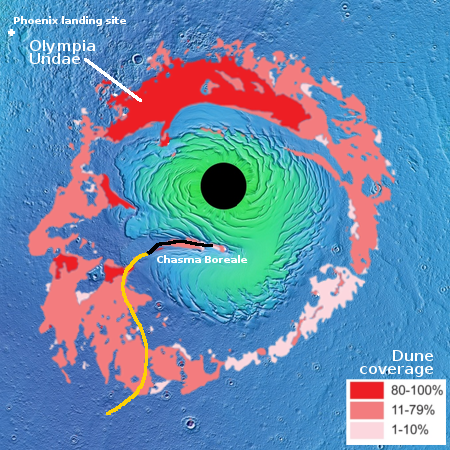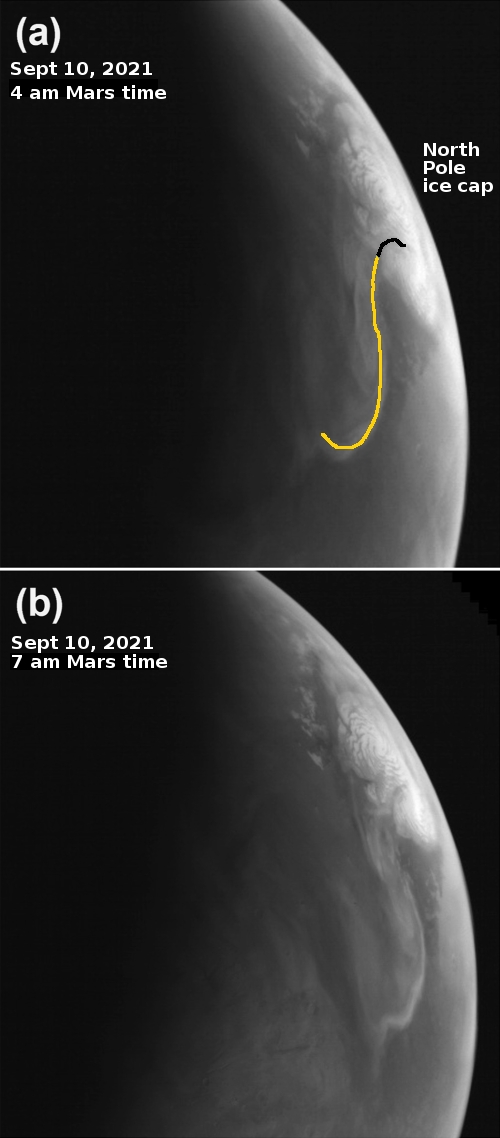Al-Amal orbiter tracks unusual northern summer dust storm on Mars
Scientists, using UAE’s Al-Amal Mars orbiter, have documented the occurrence of a rare high northern latitude summer dust storm whose origin appears linked to both a major canyon in the northern ice cap as well as the giant sand dune seas that surround that ice cap.
The EMM [instrument on Al-Amal] observed a distinct dust cloud on 10 September 2021. That was outside of the classical Martian dust storm season. The observed dust cloud is an arc-shaped dust storm, typically observed at the northern polar cap edge. This type of non-season dust storm is a well-known phenomenon, but this particular case is interesting because the dust cloud has frontal structure. A large atmospheric front is unusual in this location and season.
EMM’s unique observational coverage adds value to this observation, by providing a sequence of four camera images of the frontal dust cloud, separated by 2–3 hr. The frontal dust cloud shows very little movement over 7–8 hr, that is, it is quasi-stationary. We estimated the wind speed and direction by tracking internal motion of the dust cloud. In one case, the estimated wind is consistent with near-surface easterly winds at the polar cap edge.
The two images to the right are adapted from the paper’s figure 3. The yellow line in the top image indicates the location of the dust storm’s front (about 1,200 miles long), aligned with the canyon Chasma Boreale, marked by the black line, that cuts a 300-mile-long and 4,600-foot-deep gash into the North Pole ice cap.
The storm’s wind speeds were estimated very roughly to be about 16 feet per second, about 10 mph. In Mars’ thin atmosphere these winds would be so gentle that they would be almost imperceptible.
The storm front’s alignment with Chasma Boreale is intriguing, but the overview map below suggests another intriguing alignment.

The yellow-black line on the map corresponds roughly to the yellow-black line in the top image above. Note how the storm seems to sit above the giant Olympia Undae sand dune sea that surrounds the north pole ice cap. In fact, this storm seems to suggest that the dust that formed that sea might have actually come from the dust that is mixed into the cap’s water ice layers, several thousand feet thick but exposed on the walls of Chasma Boreale.
Many avalanches have been spotted on the cliff edges of the north pole ice cap, each producing small and very temporary dust clouds. The temperature differences between the top of Chasma Boreale and its floor produce winds. Both events combined could drive the dust out of the canyon and onto the sand dune sea. Thus, the sand dune sea is created, with this rare dust storm illustrating this process.
On Christmas Eve 1968 three Americans became the first humans to visit another world. What they did to celebrate was unexpected and profound, and will be remembered throughout all human history. Genesis: the Story of Apollo 8, Robert Zimmerman's classic history of humanity's first journey to another world, tells that story, and it is now available as both an ebook and an audiobook, both with a foreword by Valerie Anders and a new introduction by Robert Zimmerman.
The ebook is available everywhere for $5.99 (before discount) at amazon, or direct from my ebook publisher, ebookit. If you buy it from ebookit you don't support the big tech companies and the author gets a bigger cut much sooner.
The audiobook is also available at all these vendors, and is also free with a 30-day trial membership to Audible.
"Not simply about one mission, [Genesis] is also the history of America's quest for the moon... Zimmerman has done a masterful job of tying disparate events together into a solid account of one of America's greatest human triumphs."--San Antonio Express-News
Scientists, using UAE’s Al-Amal Mars orbiter, have documented the occurrence of a rare high northern latitude summer dust storm whose origin appears linked to both a major canyon in the northern ice cap as well as the giant sand dune seas that surround that ice cap.
The EMM [instrument on Al-Amal] observed a distinct dust cloud on 10 September 2021. That was outside of the classical Martian dust storm season. The observed dust cloud is an arc-shaped dust storm, typically observed at the northern polar cap edge. This type of non-season dust storm is a well-known phenomenon, but this particular case is interesting because the dust cloud has frontal structure. A large atmospheric front is unusual in this location and season.
EMM’s unique observational coverage adds value to this observation, by providing a sequence of four camera images of the frontal dust cloud, separated by 2–3 hr. The frontal dust cloud shows very little movement over 7–8 hr, that is, it is quasi-stationary. We estimated the wind speed and direction by tracking internal motion of the dust cloud. In one case, the estimated wind is consistent with near-surface easterly winds at the polar cap edge.
The two images to the right are adapted from the paper’s figure 3. The yellow line in the top image indicates the location of the dust storm’s front (about 1,200 miles long), aligned with the canyon Chasma Boreale, marked by the black line, that cuts a 300-mile-long and 4,600-foot-deep gash into the North Pole ice cap.
The storm’s wind speeds were estimated very roughly to be about 16 feet per second, about 10 mph. In Mars’ thin atmosphere these winds would be so gentle that they would be almost imperceptible.
The storm front’s alignment with Chasma Boreale is intriguing, but the overview map below suggests another intriguing alignment.

The yellow-black line on the map corresponds roughly to the yellow-black line in the top image above. Note how the storm seems to sit above the giant Olympia Undae sand dune sea that surrounds the north pole ice cap. In fact, this storm seems to suggest that the dust that formed that sea might have actually come from the dust that is mixed into the cap’s water ice layers, several thousand feet thick but exposed on the walls of Chasma Boreale.
Many avalanches have been spotted on the cliff edges of the north pole ice cap, each producing small and very temporary dust clouds. The temperature differences between the top of Chasma Boreale and its floor produce winds. Both events combined could drive the dust out of the canyon and onto the sand dune sea. Thus, the sand dune sea is created, with this rare dust storm illustrating this process.
On Christmas Eve 1968 three Americans became the first humans to visit another world. What they did to celebrate was unexpected and profound, and will be remembered throughout all human history. Genesis: the Story of Apollo 8, Robert Zimmerman's classic history of humanity's first journey to another world, tells that story, and it is now available as both an ebook and an audiobook, both with a foreword by Valerie Anders and a new introduction by Robert Zimmerman.
The ebook is available everywhere for $5.99 (before discount) at amazon, or direct from my ebook publisher, ebookit. If you buy it from ebookit you don't support the big tech companies and the author gets a bigger cut much sooner.
The audiobook is also available at all these vendors, and is also free with a 30-day trial membership to Audible.
"Not simply about one mission, [Genesis] is also the history of America's quest for the moon... Zimmerman has done a masterful job of tying disparate events together into a solid account of one of America's greatest human triumphs."--San Antonio Express-News



UAE seems to really be getting their money’s worth out of this spacecraft. Chapeau!